
The Family Dynasty That Pursues Perfection in Shaved Ice
For three generations, the Hansens have made summer sno-ball season in New Orleans.
Ashley Hansen grew up spending Saturday mornings watching 300-pound slabs of ice slide into her grandfather’s Jeep, grabbing chips with her sister as they splintered along the edges. Each week, Ashley and her twin sister clambered into the back of the two-door Jeep that her grandfather Ernest had transformed into a giant steel tray. Once her grandmother, Mary, had set down her purse up front, Ernest would navigate potholed streets to icehouses still wedged in odd corners of downtown or bulging in the empty spaces between suburban strip malls.
More than in most places, ice in New Orleans is a cherished and respected commodity: a requirement for the region’s seafood industry and manna for all who seek relief from the Louisiana heat. “[We] had to go early to beat the shrimpers to get the good ice,” Ashley recalls.
Sometimes Mary returned to the Jeep almost immediately, unsatisfied with the frozen offerings. Other times, she walked through warehouses like a sushi chef at Tokyo’s old Tsukiji fish market. As muscular men with giant metal tongs emerged with ice blocks from deep wooden storage rooms, she’d run a finger over each before moving in close enough to touch her nose. She could see what others could not.
The Hansens spent a day a week painstakingly seeking ice for a reason. They, as a family, had spent more than five decades on a quest to perfect New Orleans’ iconic treat: the sno-ball.
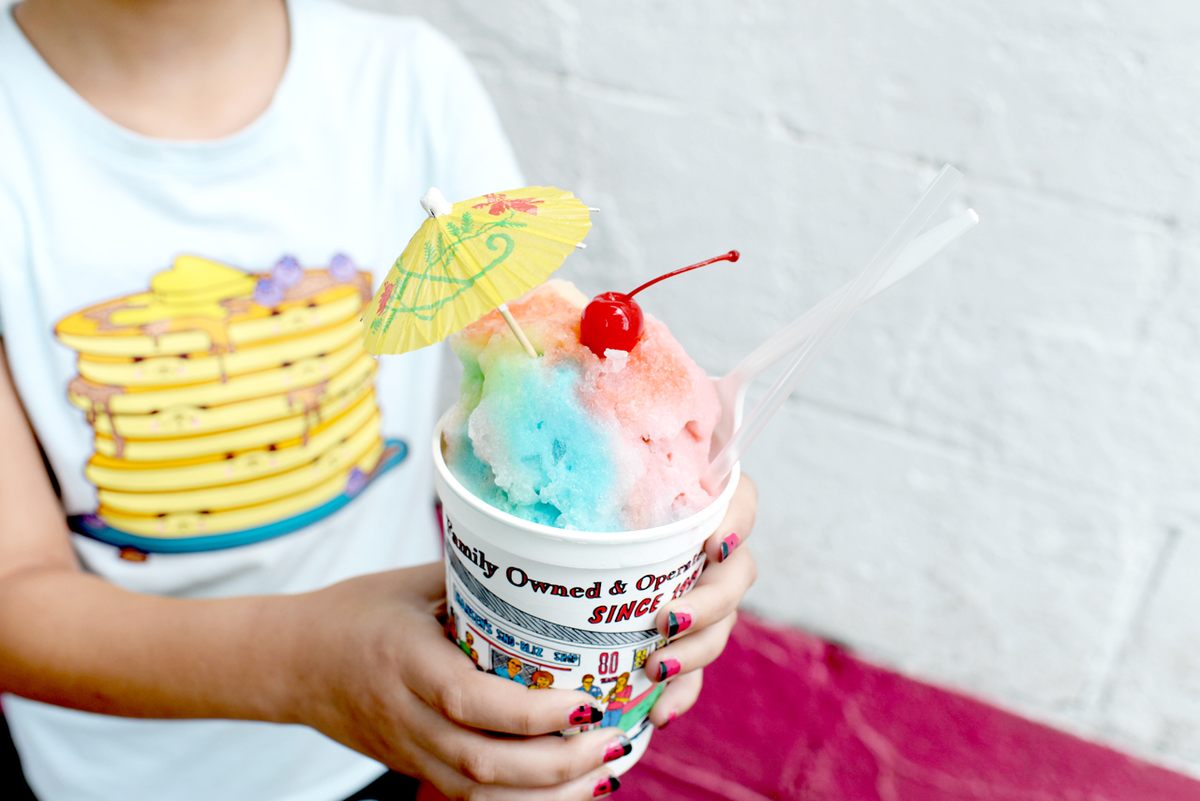
Ask any Hansen, and they’ll tell you that a sno-ball is not to be confused with a snow cone (“very coarse, syrup pooling at the bottom”) or a slushy (“more liquid than solid”). Ashley will describe a New Orleans sno-ball, pausing for emphasis, as “a cup of finely—finely shaved ice with flavored syrup.” As her father Gerard has explained, speaking of their sno-balls, “You actually put the syrup on in layers to get consistency throughout the body … The flavor stays with you throughout the process of eating it.”
While New Orleans is a town of many culinary obsessions and peculiarities, from the po’ boy to the Sazerac, from beignets to Andouille gumbo, none of these foods define an entire season. It is impossible to have summer in New Orleans without sno-balls.
On the family’s Saturday ice excursions, Ashley and her sister were not allowed to leave the car. But the pursuit of quality was practiced week after week, year after year. After a childhood spent “sitting on ice,” Ashley spent years with her 80-something grandparents ice-picking slabs into appropriately sized blocks, cleaning them with gallons of spring water, and then waiting “to let the ice harden” to an ideal point. After her grandparents passed away in 2005, Ashley, who had been running things for almost a decade, assumed control of the New Orleans institution that her grandparents opened in 1939: Hansen’s Sno-Bliz Shop.
Outside New Orleans, creating perfect snow is big business. Whether at one-run ski hills or in Winter Olympics host cities, getting man-made snow right is a multi-billion dollar industry. But Hansen’s Sno-Bliz, which recently celebrated its 80th year of a James Beard award-winning run, has done more than any institution in the U.S., if not the world, to perfect snow for eating. And the family has done it in a ramshackle concrete shed where the industrial warehouses of Tchoupitoulas Street meet the shotgun neighborhoods of Bordeaux Street.
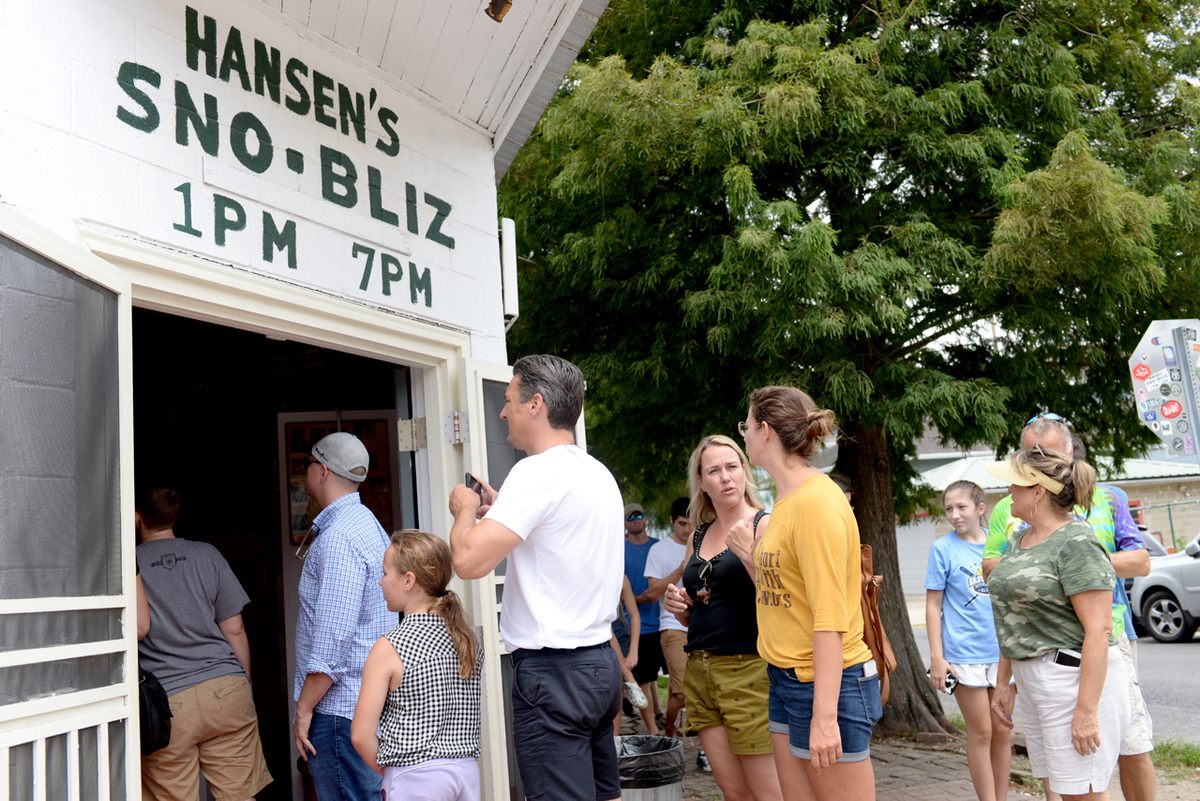
In the summer of 1934, that time of year when the Louisiana humidity seems to intensify the tropical sun like a magnifying glass, a tired man in a white apron and cap came down the street through Bayou St. John. According to the story Ashley heard Ernest recount dozens of times, the man pushed what looked like a baby carriage, but in place of the bassinet was a wooden box, an ice chest topped by a rack of glass bottles filled with brightly colored liquids. “Ice cold sno-balls! I’ve got ice cold sno-balls!” he shouted and sang. “Lemon-lime-orange-strawberry-grape-and-nectar!”
Ashley’s uncle asked her grandfather Ernest Hansen for a penny, the going rate in Depression-era New Orleans for a sno-ball. “The street sellers,” she says, “they would open the box, run the rasp over the ice block” into a deepening groove in the melting top. Then they’d whip out the sno-ball like a rabbit from a hat.
By the Depression, sno-balls were already deeply ensconced in New Orleans culture, one of the many manifestations of ice that had become borderline necessities in the sweltering city. Indeed, the very popularity of sno-balls speaks to the logical question that any summer visitor might pose: Why would anyone choose to live here?

For the better part of five months each year, the city is oppressively hot and ridiculously humid. Air has weight here. Nearby Jean Lafitte National Historical Park, where a boardwalk runs through an unwelcoming, alligator-filled swamp, offers a sense of the original landscape. As the swamp was transformed, sugar was first successfully planted and refined in America, in 1795, by the slaves of Étienne de Boré, who was later appointed mayor, just a mile from where Hansen’s now stands. When the resulting sugar and cotton booms revived American slavery, New Orleans became the most important port city in America. To be sent here as an enslaved person—and forced to work in the cash-crop fields of the Mississippi River Valley—was seen as a death sentence.
Chitimacha Indians, the Spanish, the French, enslaved Americans, refugee Haitian planters, Europeans seeking fortunes: They all lived and sweated through New Orleans’ heat. The city’s urban landscape, with its canals and streets that follow the river, all speak to the unique ecosystem of the Crescent City, and the buildings reveal the fundamental battle with the climate: 14-foot ceilings, a transom in every room, and shotgun homes as long as wind tunnels are all innovations to keep cool. But even better are the city’s many icy treats.
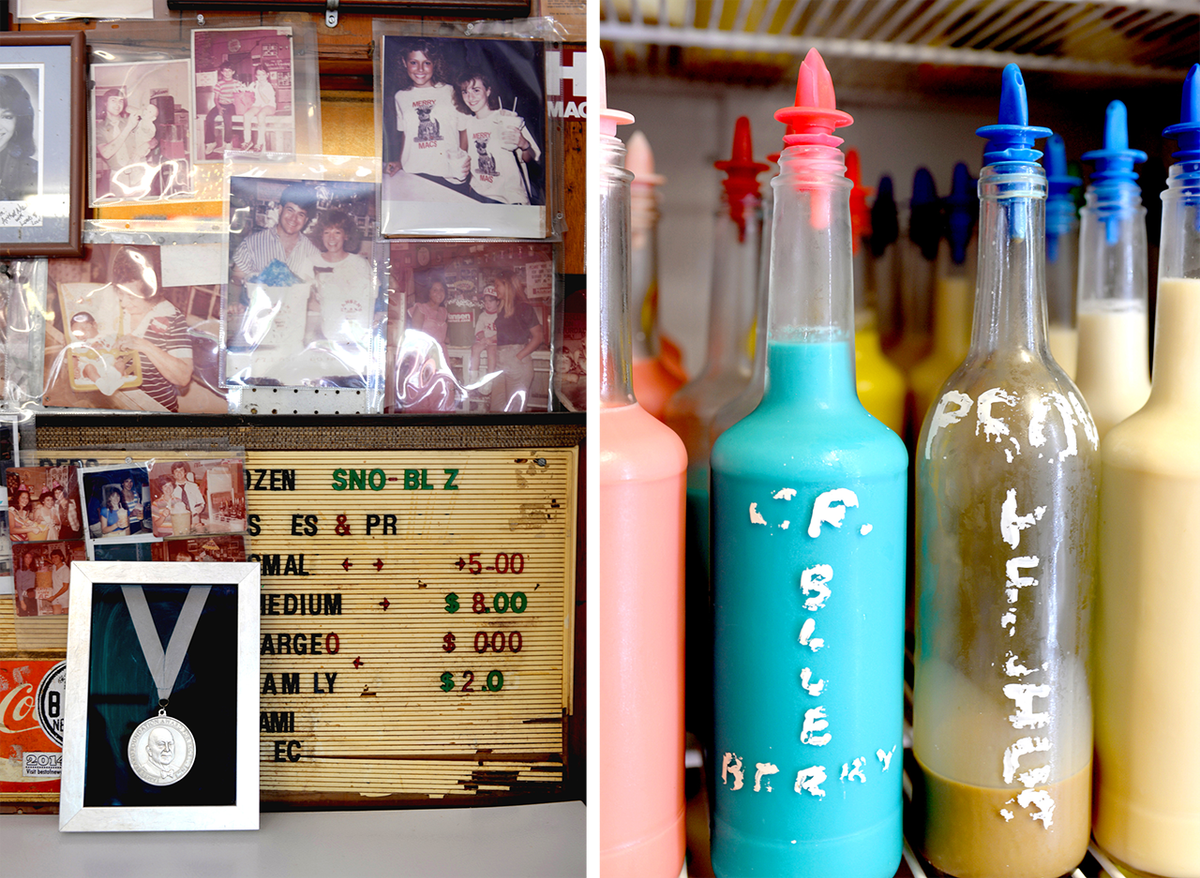
In 1822, the first shipment of natural ice, cut out of Jamaica Pond near Boston, arrived in New Orleans. It had melted substantially during its months-long journey. Still, what emerged from the hold weighed nearly 250 pounds, solid, clear, and cold as could be. Its extreme foreignness in the humid port must have seemed wrong: New Orleanians tossed the unnatural (and probably cursed) Yankee import into the swirling brown of the Mississippi River. But four decades later, when a former New Orleans slave auctioneer lit the steam engines of the Louisiana Ice. Co., which could turn the waters of the Mississippi into 20 tons of ice each day, delighted locals gathered just to watch the water freeze.
Likewise, Ernest Jr. was delighted by his pink mound of street ice, but his father didn’t think it was clean enough. “That’s filthy,” Ashley recalls of Ernest’s reaction. “I can make something better.” At the stand’s 50th anniversary, Ernest himself remembered that the origin of Hansen’s first motto, “Never Touched By Hand,” spoke to his vision: “I wanted the ice to go straight into the cup without touching someone’s hands,” he said.
For his part, Ernest’s hands contained tremendous expertise. He was a master machinist who spent decades tending to ships on the Mississippi. His metalwork is as charming as it is useful (he made his wife a hatchet-inspired gift every year, her birthday being February 22, the same as George Washington of mythical cherry-tree-chopping fame). So with the skills, equipment, and inspiration of this river city, Ernest worked after hours on his idea for a sanitary sno-ball. In just five months, he cast and assembled several strange-looking pieces of aluminum and stainless steel into the world’s first motor-driven ice-shaving machine.
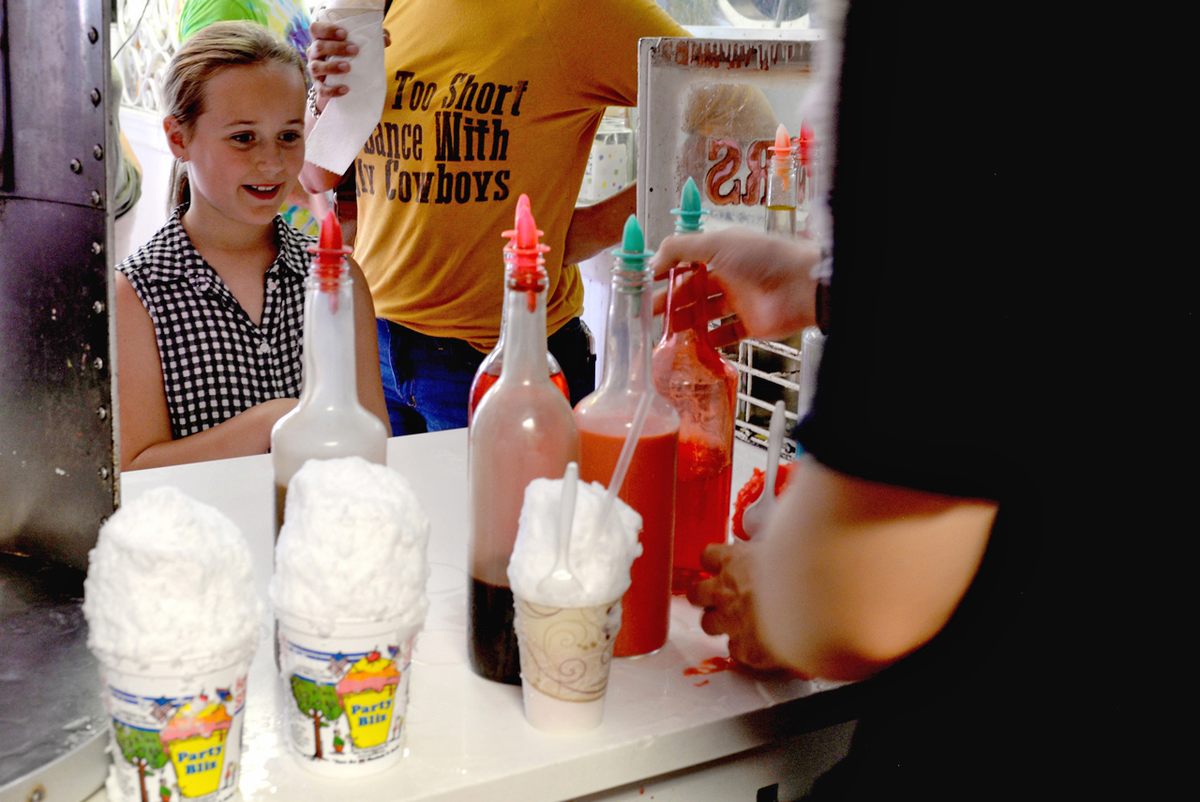
There is always a line at Hansen’s, and the wait is never dull. I have met tourists who, after one bite, come back every day of their visit. I have met construction workers and garbage men desperately trying to get a Hansen’s sno-ball during a quick break. I have met kids just out of school for the day. Black and white, young and old, all of New Orleans waits in this line for a frozen delight that sells for just two dollars.
Since 1939, reaching the front has meant not just getting to order, but to see Ernest’s machines fill your cup with a blizzard of snow. Ernest’s 1934 prototype (“Ernest Jr.”) sits above the fridge, while the machine Ernest built in 1939 (“Ernest”) and one other (“Nacho”) sit on the counter, each a bright silver contraption the size of a small dresser. “Mary” lives on a portable tray so that Hansen’s can cater events.
Since I first visited during Ashley’s reign, I’ve watched this muscly little woman feed rectangles of ice the size of a bread loaf into Ernest’s machines using a ratcheted metal arm. She holds a cup under the chute, but doesn’t fill it as snow starts to fly—when the blades spin, the end of the ice inevitably produces chipped ice and chunky snow. Only when the snow is perfectly fluffy does she fill the cup to almost twice its height. It’s this blizzard-like snow that blows out of the chutes hand-cast by Ernest that inspired an early customer to suggest the name “Sno-Bliz.”
Along with the daily, house-made flavors pioneered by Mary, it’s this dedication that sets Hansen’s apart from the hundreds of sno-ball purveyors in New Orleans, many with loyal followings of their own. Ashley will discard some 40 percent of the snow as insufficiently fluffy—a reflection of Hansen’s permanent motto: There Are No Shortcuts to Quality. And when she’s not behind the counter, the sno-balls are not made by just any staffer, but by one of her Lost Boys, neighborhood guys (many second- or third-generation employees) who grew up in the stand and worked their way from cleaning bottles to the mighty honor of helming Ernest’s invention.
Working those machines is a three-limbed operation: one hand on the brassed ratchet holder, a foot pedal to maintain downward pressure on the ice, and one hand under the chute, waiting for the perfect snow. Every Sno-Bliz operator has a different style, a different feel for how to determine the moment that ice and blade along with hand and cup are working together in harmony.
Some count.
Others listen.
“If the ice is too soft, it will be watery and yucky,” says Ashley. But if it’s too hard, then “the machines chatter, and they don’t cut as fine.” She has to respond to changes in temperature and humidity and the blade’s sharpness. I have seen Ashley set ice blocks out to thaw when the line stretches long but she hears the machine whine at a certain pitch. “It’s about finding that balance,” she says.

When Ernest invented his machine, he could have become the Henry Ford of shaved ice. The machine spelled the end for the once-ubiquitous, hand-shaved street-ice vendors, who were quickly replaced by shops that could house and power this new technology. Ernest handmade about a dozen Sno-Bliz machines, a handful of which he sold to New Orleans businesses, most notably the Audubon Zoo, which is still where many tourists taste their first sno-ball.
As Ashley recalls, once, when Ernest went to the zoo to make a maintenance call, “He saw kids working the machines throwing nickels into the blades and shredding the nickels.” Ernest was horrified. “They didn’t understand the product, the quality he wanted, [so] he bought them all back and never manufactured another machine.” Ashley remembers her grandparents citing their motto. “[They] couldn’t sacrifice the quality or reputation.”
Competing stands bought similar machines from emerging rivals. But when someone asked Ernest if he was going to use his patent to stifle competitors, he demurred. The Hansens did not have money for lawyers or time to cook up lawsuits. They had two young boys and two sets of aging parents. But the crux was that New Orleans sno-balls still ranged in price from two to five cents. “Who was he,” Ashley remembers her grandfather explaining, “to tell someone they could not help feed their family with those two pennies?” The patent was about recognition, not profit.
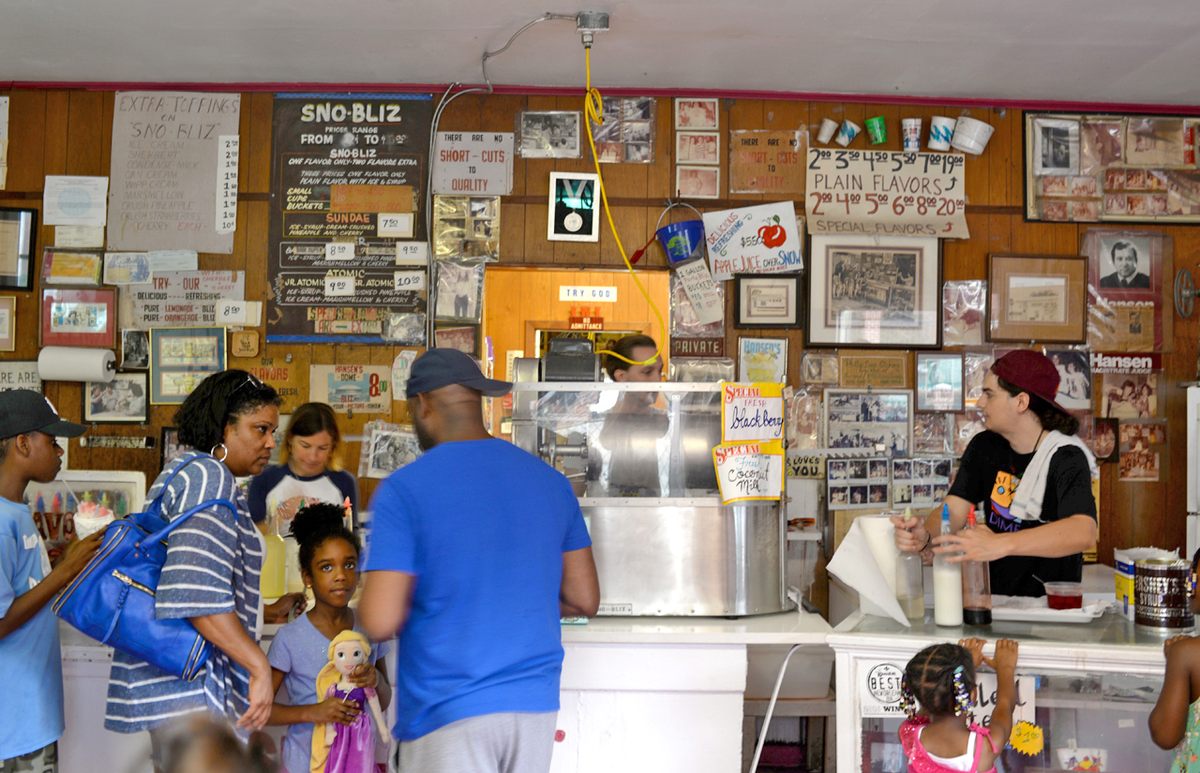
Turning the best ice into delicious snow has only ever been one part of the Hansens’ pursuit of perfection: Mary spent 70 of her years and Ashley 30 of hers perfecting a dizzying range of syrups to match the magic of Ernest’s snow.
As soon as Ernest assembled his first machine, Mary, the Italian-American daughter of a family that owned a fruit stand, began crafting flavors, which she first served atop sno-balls under a chinaberry tree behind her parent’s house. Syrups such as Mary’s Own, a tart strawberry, reflect her own family history. Countless others speak to a city made by black and white people and infused with traditions of French, Spanish, and African ancestry. Cream of Coconut and the even more traditional Hard-Candy Coconut highlight the New Orleans that is more Caribbean than American. Vanilla Bean, the backbone of flavors such as Cream of Ice Cream and Nectar-Cream, reveals the city’s French connections, and the role slavery played in the succesful cultivation of the valuable vanilla orchid. Ernest’s Own, a root-beer flavor beloved by the stand’s founder, traces back to the Sassafras beverages concocted by native peoples throughout the Americas.
Unlike the syrups shipped around the world by Coca-Cola and other food and beverage titans, Hansen’s syrups are artisanal, practically farm-to-table, just more local. Making seasonal favorites, from Blood Orange to Pear, Blueberry to Kumquat, starts with neighbors dropping off bags of fruit from their backyard. The signature syrup, Satsuma, can only be made with this Louisiana citrus, whose trees spill out of yards all over New Orleans.
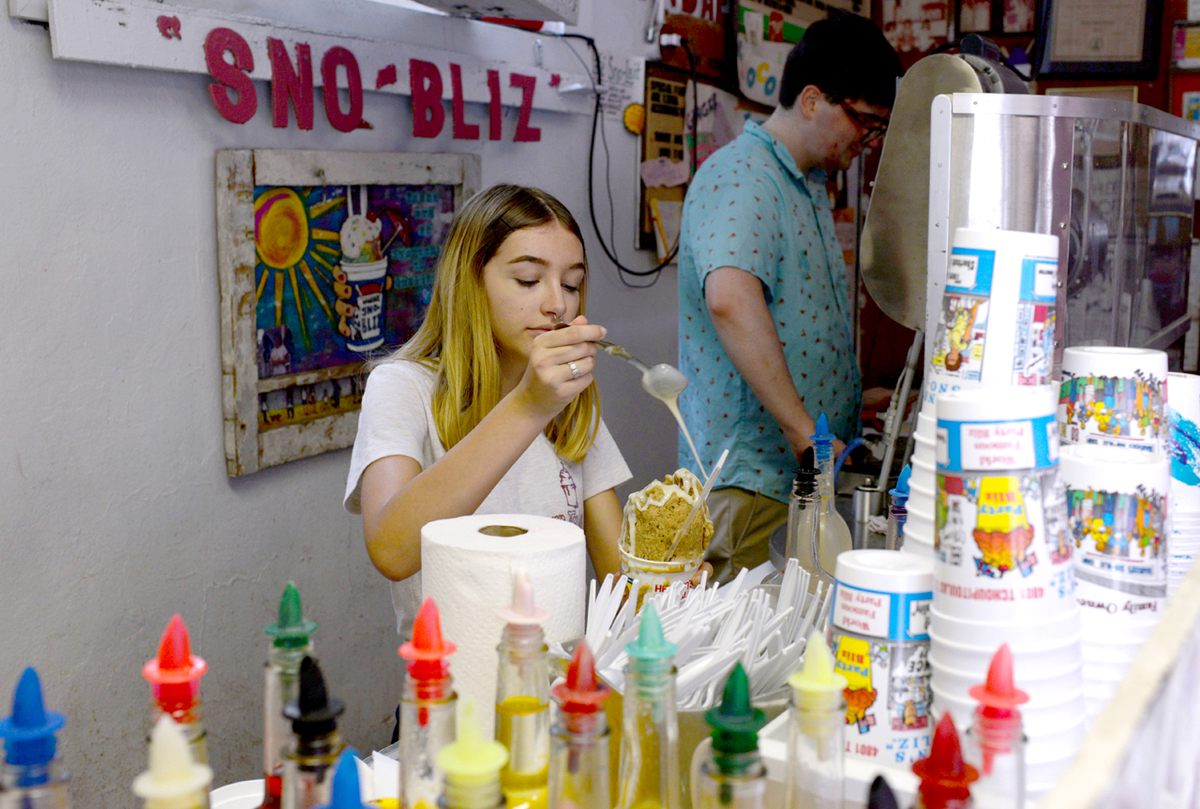
With her hyperlocal syrups, Mary matched Ernest’s uncompromising, often counter-capitalist commitment to quality. And just as Ernest could not sell his machines to anyone who might disrespect them, Mary, who came from a family that told guests to “sit down, mangiare-mangiare,” would never move a line along with maximum efficiency. Following in her footsteps, it is not unusual for Ashley to chat with longtime customers for 20 minutes before making them their Sno-Bliz, even as dozens of sno-ball seekers wait in the Louisiana heat.
When the Depression was at its worst, said Gerald Hansen, who is Ashley’s father and a district judge, people would come by with their children and say, “Oh, hi Mrs. Hansen. We just came to visit, you know, we don’t want a sno-ball today.” Without a moment’s pause, Mary would reply, “But today is treat day for children,” he added. “She’d give them free sno-balls … And you know she probably gave more away in the first five years than she sold.”

The result, from decades of this graciousness, is fierce loyalty and familiarity. When Hansen’s reopened after Hurricane Katrina, one of the first businesses in the area to do so, Ashley recalled a woman sweeping in and declaring, “I need a chocolate sno-ball. This is the only place I’m going to get my chocolate sno-ball ‘cause Miss Mary made the best and this is what she gave to me.” To paraphrase the poet of the shared meal, Anthony Bourdain—who himself broke snow with Ernest, Mary, and Ashley, and declared that there was nothing in the world like a Sno-Bliz—Sno-balls “make the society, hold the fabric together.”
Even in this city of endless food, drink and celebration, Hansen’s is on every list of must-do’s in New Orleans. But the hundreds-deep line that spills up Bordeaux Street on the hottest August days is not made up, even mostly, of tourists. All of New Orleans stands in that line, because despite neighborhood allegiances or even sides of the river, customers will not take shortcuts to quality either. They come for flavors that have defined New Orleans since the 1880s, sought-after toppings such as Bananas Foster over a chicory-strong Café-Sno-Lait Sno-Bliz or pink Nectar Cream topped with condensed milk. They come to be served that perfect snow. Customers know Hansen’s is there for them because everyone has always been served—during the Jim Crow era of segregation, the Hansens had refused to follow separate-but-equal laws since their backyard chinaberry pop-up.
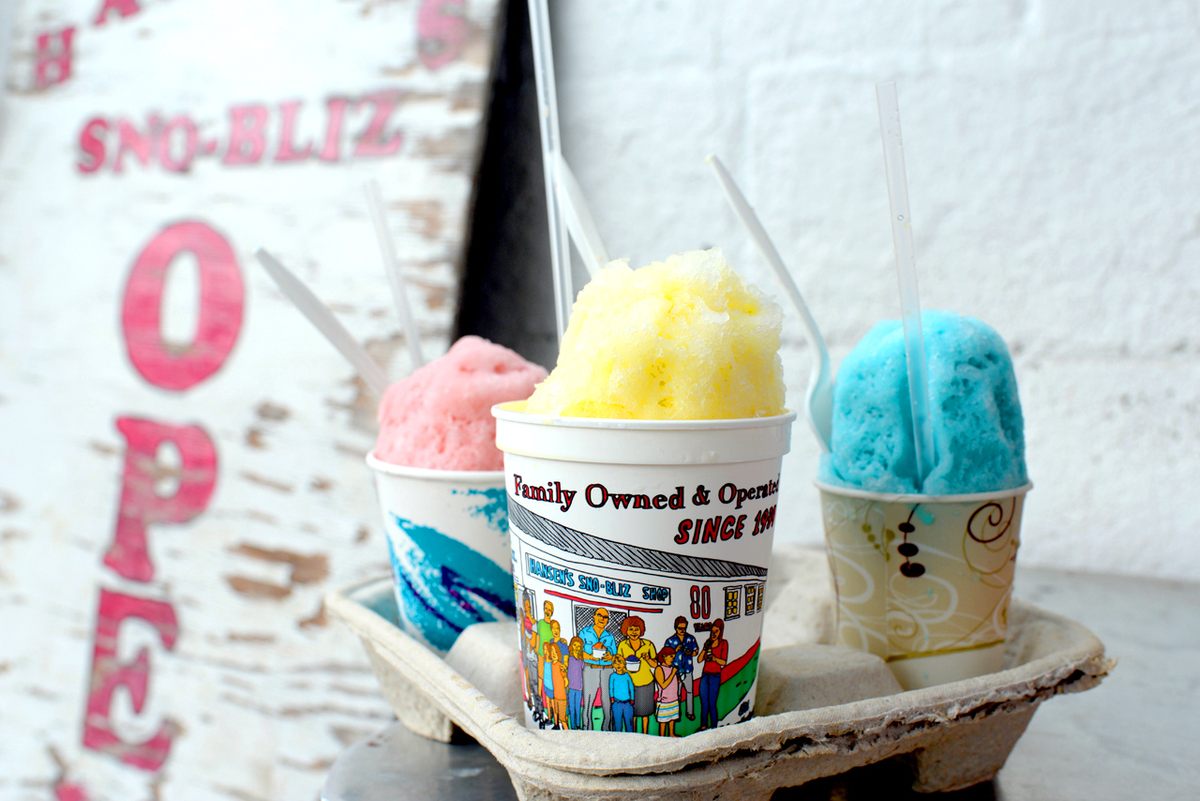
Defined by its people, Hansen’s is beloved decrepitude. It is the James Beard medal shining near hand cut letters under 60 layers of pink paint. As you wait, the wait becomes important, an opportunity to take in the multitudes of this shabby glory. As you talk to people around you, you learn their stories and their flavors. You make friends. Photo collages of 50 years of neighborhood kids cover the walls, along with 50 years of peculiarly Crescent City traditions and poems and signage from every decade.
With that first taste, that perfect spoonful of perfect snow, everyone wishes their own town or street had a branch of this perfection, this joyous place. And yet, as you walk outside, you realize the impossibility of this stand in some gleaming space in the French Quarter or, God help us, another city or state. There cannot be Sno-Bliz franchises or a factory churning out machines, because a Hansen would not be behind the counter and Ernest’s hands would not have made the machine. You can get shaved ice and syrup the world over. Some places even call what they are selling a snow-ball—visit Baltimore for a taste. But a Sno-Bliz, this quintessential representation of all that is New Orleans, could not exist anywhere but here.
Gastro Obscura covers the world’s most wondrous food and drink.
Sign up for our email, delivered twice a week.


















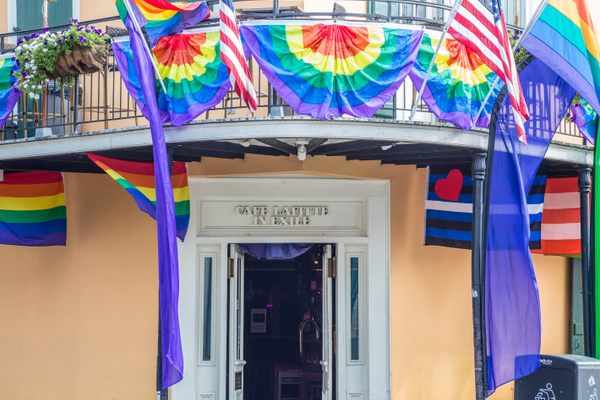
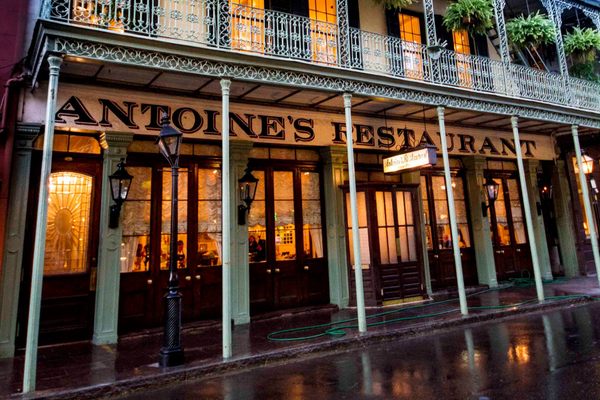
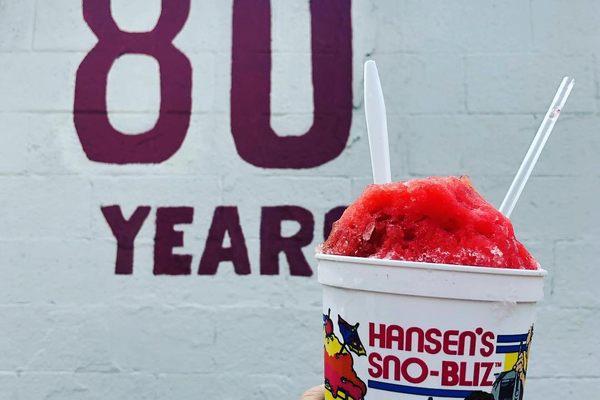
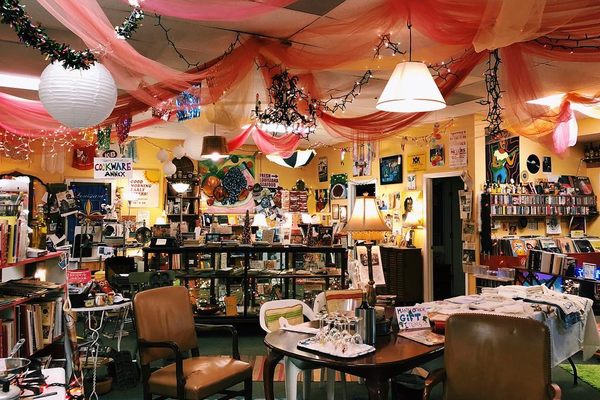




Follow us on Twitter to get the latest on the world's hidden wonders.
Like us on Facebook to get the latest on the world's hidden wonders.
Follow us on Twitter Like us on Facebook